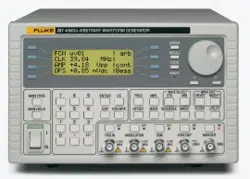Loading ...
Loading ...
Loading ...

Standard Waveforms
Setting Generator Parameters 5
entered as 12340, 12340·00, or 1·234 exp 4 etc. However, the display will always
show the entry in the most appropriate engineering units, in this case
12·34000000 kHz.
With period selected instead of freq the frequency can be set in terms of a period,
for example 123·4 µs can be entered as·0001234 or 123·4 exp -6; again the display will
always show the entry in the most appropriate engineering units. Note that some rounding
may occur when switching between frequency and period or vice-versa.
Square wave, generated by clock synthesis, has 8-digit resolution for both frequency and
period entry.
Turning the rotary control will increment or decrement the numeric value in steps
determined by the position of the edit cursor (flashing underline); the cursor is moved
with the left- and right-arrowed cursor keys.
Note that the upper frequency limits vary for the different waveform types; refer to the
Specifications section in chapter 1 for details.
Amplitude
Pressing the AMPL key gives the AMPLITUDE screen:
AMPLITUDE:
+20.0 Vpp
Vpp Vrms
dBm load:hiZ
The waveform amplitude can be set in terms of peak-to-peak volts (Vpp), rms volts
(Vrms) or dBm (referenced to a 50 Ω or 600 Ω load). For Vpp and Vrms the level
can be set assuming that the output is open-circuit (load:hiZ) or terminated
(load:50
Ω or load:600Ω); when dBm is selected termination is always assumed
and the load:hiZ setting is automatically changed to load:50
Ω. Note that the actual
generator output impedance is always 50 Ω; the displayed amplitude values for 600 Ω
termination take this into account.
With the appropriate form of the amplitude selected (indicated by the filled diamond) the
amplitude can be entered directly from the keyboard in integer, floating point or
exponential format. For example 250 mV can be entered as·250 exp -3 or 250, etc. The
display will always show the entry in the most appropriate engineering units, in this case
250 mV.
Turning the rotary control will increment or decrement the numeric value in steps
determined by the position of the edit cursor (flashing underline); the cursor is moved
with the left- and right-arrowed cursor keys.
Alternate presses of the ± key will invert the signal at the MAIN OUT socket; if the
DC OFFSET is non-zero the signal is inverted about the same offset. The exception to
this occurs when the amplitude is specified in dBm. Since low level signals are specified
in -dBm (0 dBm = 1 mW into 50 Ω = 0.224 mV rms) the - sign is interpreted as part of a
new amplitude entry and not as a command to invert the signal.
Note that for DC, sin(x)/x, pulse train, arbitrary and sequence, the amplitude can only be
displayed and entered in the Vpp form; further limitations on pulse-train, arbitrary and
sequence amplitude are discussed in the appropriate sections.
5-3
1.888.610.7664 sales@GlobalTestSupply.com
Fluke-Direct.com
Loading ...
Loading ...
Loading ...
